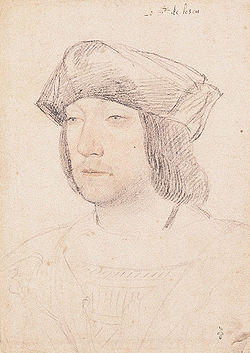|
Odet of Foix, Viscount of Lautrec
 Odet de Foix, Vicomte de Lautrec (1485 – 15 August 1528) was a French military leader. As Marshal of France, he commanded the campaign to conquer Naples, but died from the bubonic plague in 1528. BiographyOdet was the son of Jean de Foix-Lautrec[1] and Jeanne d'Aydie. He and his two brothers, the seigneur de Lescun and the seigneur de l'Esparre or Asparros, served Francis I of France as captains; and the influence of their sister, Françoise de Châteaubriant, who became the king's mistress, gained them high office.[2][3] In 1516, as marshal of France, Odet was made governor-general of the Milanese duchy,[4] but his severity made the French occupation insupportable.[3] He was present at the Field of the Cloth of Gold being in Francis I's royal entourage.[5] Odet arrived to resume the siege of Brescia, and on 26 May 1521, the Spanish and German garrison surrendered.[6] The surrender was caused by the dissonance between the two factions, while Brescia was given over to Venetian commissioner, Andrea Gritti.[6] In 1521 he succeeded in defending the Milan against the Spanish army. In 1522, under pressure from unpaid Swiss troops,[7] Odet attacked entrenched Spanish-Imperial positions and was completely defeated at the Battle of Bicocca, losing Milan in the process.[8] Odet fled back to France, and supervised the hostage exchange of Francis' sons following the latter's defeat at Battle of Pavia.[9] Sometime after his wife's death, Odet married Jeanne de Croy.[10] In 1527 he received command of the army to conquer the kingdom of Naples.[11] The defection of Andrea Doria and an outbreak of the plague or cholera in the French camp brought on a fresh disaster.[12][3] Odet himself caught a disease and died on 17 August 1528.[12] MarriageOdet married Charlotte d'Albret (1495–1527) in 1520.[10] They had: References
Sources
|